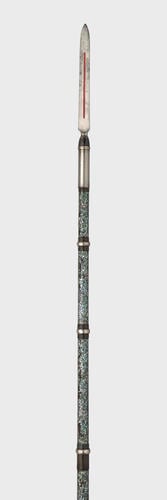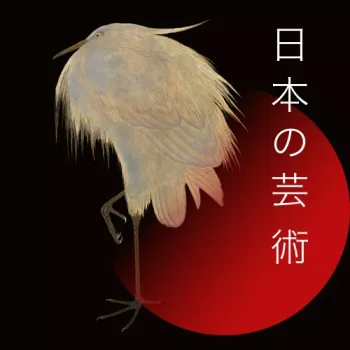Spear (yari) blade, 1750-1850; mount, 1800-50
Steel, lacquered wood, mother-of-pearl | 390.0 x 3.1 x 3.1 cm (whole object) | RCIN 71798
-
Spears (yari) were widely used in Japan during the ‘Period of Warring Provinces’ (Sengoku Jidai, 1467–1568). They were an effective and cheap means of arming the ever-expanding armies of foot soldiers (ashigaru). The simplest yari had shafts made from bamboo or oak. The shape of spearheads varied: these examples have three-sided straight steel blades (sankaku yari), which originally would have had short lacquer scabbards. They are attached to the shaft by a tapering tang which is slotted into the top of the spear and fixed with a bamboo peg. A metal sleeve at the top of the shaft prevents the wood from splitting, and reinforcing rings are found at intervals along the rest of the length.
During the peaceful Edo period, yari were carried by large numbers of lower-ranking samurai in the sankin kōtai processions to and from the shōgun’s court. To add to the splendour of the procession, the yari were frequently remounted with shafts decorated with small pieces of mother-of-pearl inlaid into lacquer.
This yari along with RCIN 71797, 71802, 71803, 71804 and 71807 form part of a set of 50 sent to Queen Victoria by Tokugawa Iemochi in 1860. Ten were given by Queen Victoria to the South Kensington Museum in 1865. The spears which remain in the Royal Collection vary in length, which suggests that some have been cut down, probably for the purpose of display. Four were mounted on the south wall of the Grand Vestibule at Windsor Castle in c.1905–10, where they formed part of a larger display of Japanese arms and armour.
Text adapted from Japan: Courts and Culture (2020)Provenance
One of a group of similarly decorated yari sent to Queen Victoria by Tokugawa Iemochi of Japan via Sir Rutherford Alcock, the first consul-general in Japan. On a translated list of gifts dated 14 July 1859, and received by Alcock on 27 September 1859, they are described as ''50 Nagazi Tuli (spears'). At least ten were sent by Queen Victoria to the South Kensington Museum (now the V&A), London, in 1865.
A 'Treaty of Peace, Friendship and Commerce' was ratified between Queen Victoria and the Tycoon of Japan at Yedo on 11 July 1859 and presented to Parliament in 1860.
Some of the yari possibly appear mounted on the upper wall of the Grand Vestibule in a photograph dated 1902, RCIN 2936804. -
Creator(s)
(nationality)Acquirer(s)
-
Medium and techniques
Steel, lacquered wood, mother-of-pearl
Measurements
390.0 x 3.1 x 3.1 cm (whole object)
Category
Object type(s)
Place of Production
Japan









